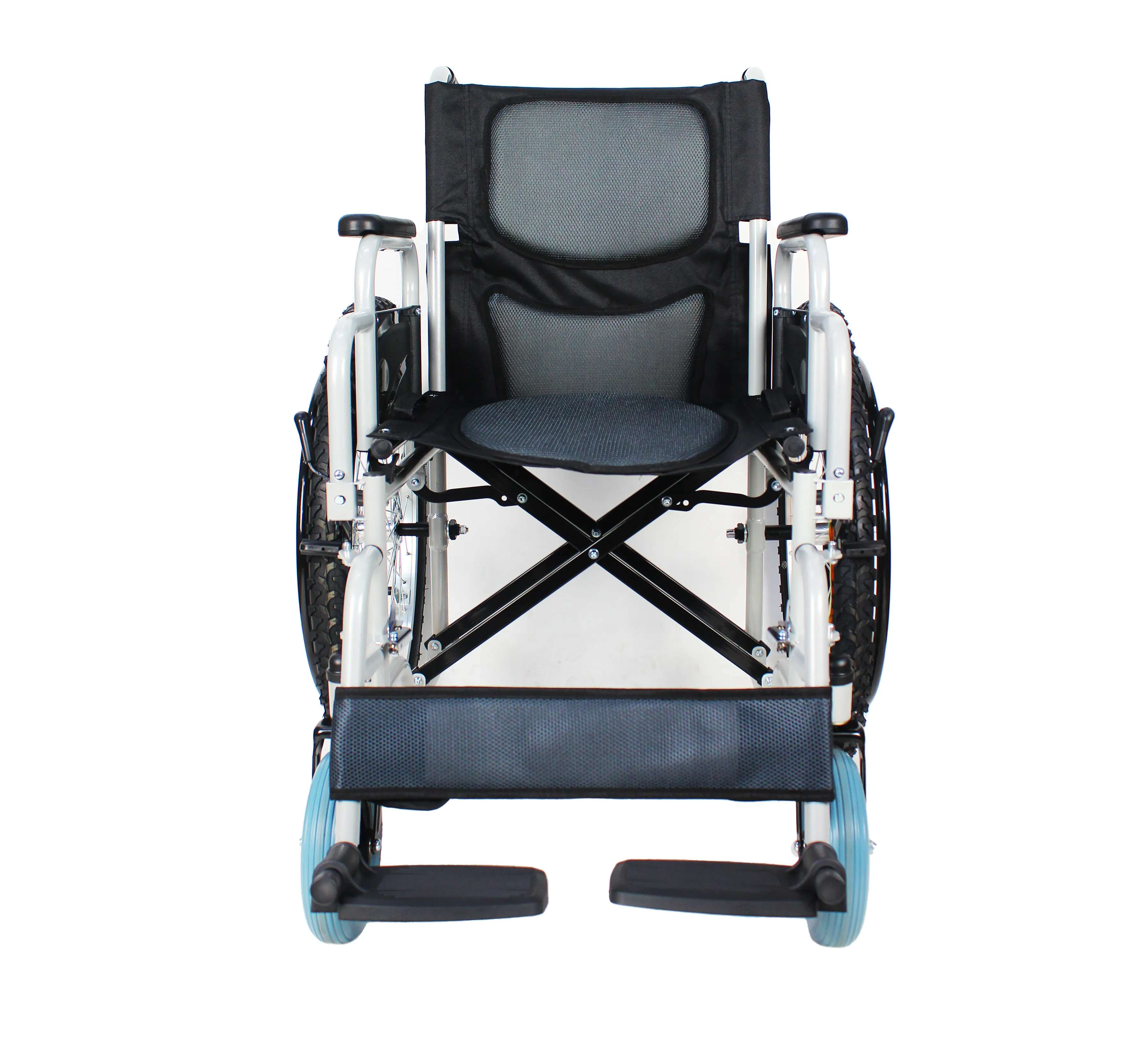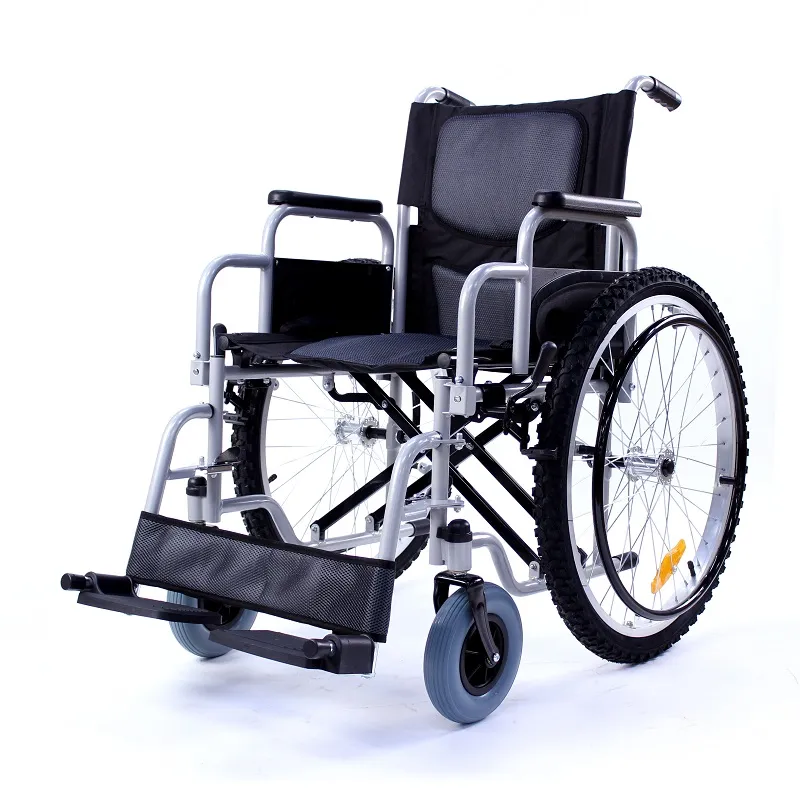With the aging population, the demand for manual wheelchairs has increased significantly, particularly in nursing homes, rehabilitation centers, and home care settings, where manual wheelchairs have become a "second pair of legs" for many elderly people with limited mobility.
Among the many wheelchair parameters, "width" is an often overlooked yet crucial detail. Wheelchair width not only affects the user's comfort and safety but also determines whether the wheelchair can navigate hallways, elevators, bathrooms, and other living spaces.
So, what is the optimal width for a manual wheelchair for seniors? What are the professional considerations for width design in lightweight manual wheelchairs?
This article will delve into the core question of "the ideal width for a manual wheelchair for seniors," focusing on structural standards, physiological fit, safety, convenience, and indoor space compatibility.

What exactly does "width" refer to when it comes to manual wheelchairs?
Before answering the question, "What is the width of a manual wheelchair suitable for the elderly?" It's important to clarify that "width" has two distinct meanings in wheelchair design:
· Overall width: This refers to the distance between the left and right outermost sides of the wheelchair. This is typically determined by the rear wheel position and frame structure, and affects whether the wheelchair can fit through door frames, hallways, and other spaces.
· Seat width: This refers to the distance between the armrests on either side of the seat, a key parameter that directly impacts passenger comfort.
This article focuses on the latter, seat width, as it is the dimension most closely aligned with the anatomy of the elderly.
Definition and Width Design Principles of a Lightweight Manual Wheelchair
1. What is a lightweight manual wheelchair?
A lightweight manual wheelchair is a convenient manual wheelchair made of lightweight materials such as aluminum alloy, carbon fiber, and titanium alloy. It typically weighs less than 14 kg and features easy folding, portability, and maneuverability. It is widely used for short trips, hospital care, and home rehabilitation, and is particularly popular with the elderly and their caregivers.
Three core principles for width design:
1. Ergonomics: The seat width must fit the width of the elderly's pelvis and outer thighs to avoid pressure or tilting;
2. Meeting living environment constraints: The vehicle width must be kept below the door frame of most homes (approximately 70 cm);
3. Balancing maneuverability and portability: Too wide increases weight and difficulty in carrying, while too narrow compromises comfort and stability.

What are the standard seat widths for manual wheelchairs suitable for the elderly?
According to domestic and international medical assistive device design specifications and clinical rehabilitation engineering recommendations, the seat widths of manual wheelchairs suitable for the elderly generally fall within the following standard dimensions:
Standard seat width | Suitable for hip widths | Recommended body types |
| 40cm (16 inches) | 33–38cm | Older adults with average body types |
| 43cm (17 inches) | 36–41cm | Slightly wider body types, more common among men |
| 46cm (18 inches) | 39–44cm | Older adults with slightly overweight body types |
Important Tips:
· The seat width should be slightly larger than the hip width by 2-3 cm to prevent accumulation of clothing and facilitate transfer;
· A seat that is too wide can cause the occupant to "sway" in the wheelchair, resulting in a loss of support;
· A seat that is too narrow can compress the soft tissues of the thighs, leading to poor circulation and the formation of pressure sores.
Therefore, the seat width of a suitable lightweight manual wheelchair must be customized to meet the individual differences of the elderly.
Common Widths and Fitting Recommendations for Lightweight Manual Wheelchairs
Lightweight manual wheelchair manufacturers typically offer 3-5 standard seat widths to meet the needs of different groups:
Seat Width | Body Fit | Notes |
| 38cm (15 inches) | Intended for elderly women weighing under 50 kg with smaller frames | Few manufactured, mostly custom-made |
| 40cm (16 inches) | The most common standard width on the market, suitable for most elderly people | Highly versatile |
| 43cm (17 inches) | Designed for tall or overweight elderly people | Slightly heavier but more comfortable |
| 46cm (18 inches) | Suitable for those with a higher BMI or wearing heavy winter clothing | Heavy weight |
| 48cm and above | Non-standard seat width, often used for heavy manual wheelchairs | Not classified as a lightweight manual wheelchair |
When choosing a lightweight manual wheelchair, in addition to considering body measurements, you should also consider usage scenarios such as clothing thickness (summer or winter), door width, and elevator dimensions.

The Impact of Improper Seat Width Selection on Elderly Health
If a lightweight manual wheelchair is not suitable for the elderly, the negative impacts go beyond simply being uncomfortable. It can also lead to the following problems:
1. Consequences of Too Small a Width:
· Pressure on the outer thighs, causing blood circulation problems;
· Pelvic tilt, causing lumbar and sciatic nerve pain;
· Long-term pressure on areas prone to pressure sores;
· Difficulty fitting into the seat when wearing winter clothing, resulting in reduced use.
2. Consequences of Too Large a Width:
· Insufficient pelvic support, resulting in an unstable sitting posture;
· Elderly individuals are more likely to slip when moving side to side;
· Uneven force on the axles when pushing the wheelchair, increasing wear;
· Increased weight, affecting portability.
Therefore, choosing a lightweight manual wheelchair with the appropriate seat width is fundamental to improving the quality of life and safety of the elderly.
How to correctly measure the seat width requirements of the elderly?
To scientifically select a lightweight manual wheelchair, it is crucial to measure the elderly's seat width requirements. You can refer to the following steps:
1. Prepare a sturdy, straight-backed chair for the elderly to sit on.
2. Use a tape measure to measure the distance between the widest points of the left and right thighs (hips + widest thighs).
3. Add a 2-3cm margin to the measurement to determine the most suitable seat width.
4. Refer to the lightweight manual wheelchair seat width chart for selection.
For example, if the measured hip width is 38cm, adding a 3cm safety margin yields an optimal seat width of 41cm. A wheelchair with a 43cm seat width can be selected.

The impact of the indoor environment on wheelchair width restrictions
In addition to the elderly's physical size, the "accessibility restrictions" of the home environment are also key factors in determining the overall wheelchair width (overall vehicle width).
Common Scenarios | Standard passage width | Recommended wheelchair-accessible vehicle width |
| Bedroom Door | 70–75cm | Total wheelchair width ≤ 65cm |
| Bathroom Door | 65–70cm | Total wheelchair width ≤ 63cm |
| Elevator Opening | ≥75cm | Most lightweight wheelchairs are compatible |
| Subway Security | ≥75cm | Recommended seat width ≤ 43cm |
Note:
The overall width of a lightweight manual wheelchair is typically 15-20cm wider than the seat width (due to protruding tires and armrests). For example:
· A wheelchair with a 40cm seat width has a total vehicle width of approximately 58-60cm;
· A wheelchair with a 46cm seat width may have a total vehicle width of 64-66cm.
Therefore, in a space-constrained home environment, it is recommended to prioritize a lightweight manual wheelchair with a seat width no greater than 43cm.
Conclusion: Choosing the Right Width is Key to Safety and Comfort
Based on the above analysis, the seat width of a lightweight manual wheelchair suitable for the elderly is typically between 40-43cm, suitable for those with average to slightly overweight builds. The overall vehicle width should be kept within 65cm to accommodate home mobility. Specific considerations for selecting a wheelchair include:
· The width of the elderly's hips and thighs;
· Individual weight and height;
· Seasonal wear (a wider seat is required in winter);
· Living environment restrictions (doorframes, elevator width);
· Frequency of use and range of motion.
Although seat width may be small, it's crucial for the safety and health of elderly people during daily travel. Only through scientific selection, precise measurement, and proper use can lightweight manual wheelchairs truly realize their convenience and comfort, becoming a valuable aid for elderly people's safe travel.
Does Dayang Medical manufacture hospital beds?
Yes, hospital beds are one of our key products. As a professional China manufacturer, Dayang Medical supplies both manual and electric hospital beds designed for clinics, hospitals, and home care. All beds are CE and FDA certified, ensuring high quality and safe use.
Buyers can purchase at wholesale prices, with factory discounts for bulk orders. Customized options are also available for brands requiring OEM or ODM services. If you are purchasing hospital beds from China, Dayang Medical offers affordable solutions with factory-direct sales and low prices.










